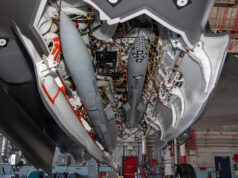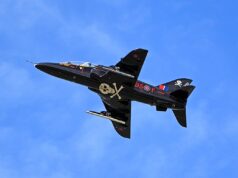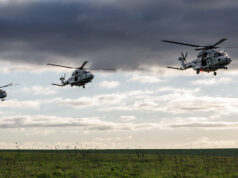Britain is to purchase three solar powered Zephyr 8 unmanned aircraft from Airbus.
Zephyr is unique aircraft that offers a satellite like capability to provide wide area surveillance and coverage at low cost, leading to it being designated HAPS (High Altitude Pseudo-Satellite) by the company. The aircraft is powered solely by the sun and flies above the weather autonomously for months. Airbus believe that Zephyr fills a capability gap between satellites and unmanned aircraft.
It was reported at the time by many news outlets that the predecessor of the current Zephyr aircraft, the Zephyr 7, underwent testing with the Ministry of Defence in 2014. It reportedly reached an altitude of 70,000ft. It was also the first HAPS to receive a Military Aviation Authority registration, PS001.
The Zephyr aircraft, with its 28 meter wingspan, will be capable of taking a 5kg payload up to a height of about 70,000ft for up to three months, giving the United Kingdom the ability to conduct surveillance at a fraction of the cost of a satellite and for significantly longer than other aerial platforms.
According to the manufacturer:
“Zephyr provides continuous surveillance, communications and monitoring services across areas hundreds of kms wide. Airbus has developed and proven its high resolution imaging and high bandwidth communication services and is developing ever more capable payloads to further improve the range and value of services available. As technology advances, Zephyr can be landed (unlike satellites), re-equipped to take full advantage of the next generation of payloads and re-deployed in short timescales.”
Paul Brooks, Airbus Defence and Space’s head of HAPS business development said:
“Satellites are brilliant at global coverage, but they have a problem with persistence. Aircraft are good for local stuff, but they’re not very persistent and they’re very local. Astrium with their expertise in UAVs and satellites was starting to look at the gap between the two. Meanwhile, Qinetiq had Zephyr, and they were saying, ‘Well, we’re an R&D house: we’re not quite sure how this fits in.’ So in 2013 we took Zephyr into Airbus and married the two together. Basically, Zephyr is a satellite with wings.”
The Zephyr 8 is expected to fly for the first time next year and deliveries are expected to take place within the next two years.














I am aware that Qinetiq did most if not all of the R&D for Zephyr in the UK. Will Airbus be building them here as well?
good creative
Great Man ….
smart thoughtful guy!!
As forecast in SDSR15. Excellent leading edge stuff.
How about building some bloody warships!! :@
What you mean like the ones we are currently building? Remember there is more to defence than just the Royal Navy!
Scraping the barrel a bit reporting a story from last year as if it was new information.
They repost articles on here regularly to ensure all can see them
Hi David Gareth Owen, a few articles showcasing important developments are reposted every few months to ensure more can see them.
For example, almost 90% of the views this article has had from this post are new. Why do we do this? Well, aside from letting new readers see the article, it also grows our reach.
In addition, we’re a small team of volunteers so we don’t always have the time to write new content but if you feel you would have the time, please message us if you wish to contribute.
UK Defence Journal ok I will
What’s with all the negative comments? Some of us find it interesting. If you don’t like it read something else. No wonder the Aussies call us Whingers!
If you’ve got something positive to post, id like to read that. No inter-service bias either. Thought ANYTHING that’s good news for the Forces would be welcomedelighted not criticized.
[…] UK to purchase solar HALE UAV […]
This is a big step forward for the UK’s ability to detect and watch threats to it’s national security, however I saw no mention of the zephyr’s stealth capability so my feeling is this may be another British white elephant in all honesty, it’s all very well and good having a high altitude aircraft at your disposal, but if you cannot defend it; what’s the point?